
This pathology is getting younger every year. Nowadays, at the age of 30-35, people suffer from this after a long day at work. Due to physical inactivity and intense work at the computer, pathologies arise early and actively develop.
Therefore, special physiotherapy complexes have been developed to improve blood circulation in the neck with cervical spondylosis. Performing them daily for 10-15 minutes will reduce or inhibit the likelihood of developing pathological changes.
The best set of exercises for the neck to treat cervical spondylosis is chosen by the doctor. But for prevention, you can use widely known ones. We will tell you about 10 of the best of them today.
Characteristics of cervical spondylosis
This is a degenerative disease that occurs in people who are susceptible due to negative environmental influences or poor lifestyle.
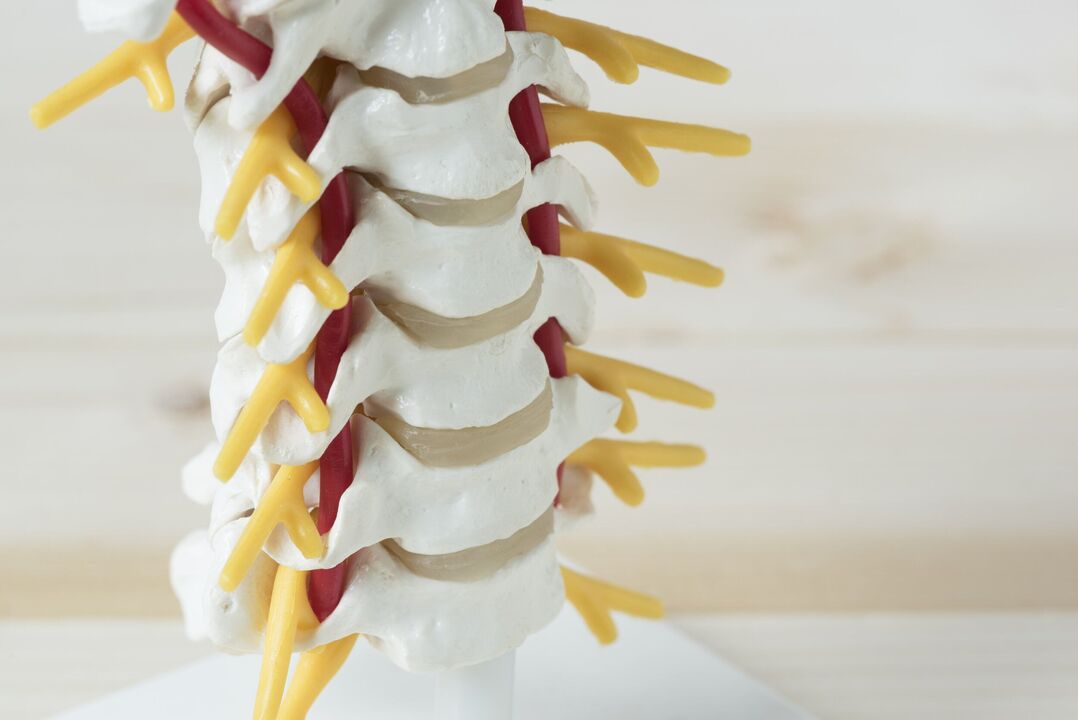
There are simple medical treatments. exercises for the muscles of the neck, back and vertebrae to relieve pain in the neck and back of the head, to combat exacerbation of osteoarthritis in the cervical spine, protrusion, to aggravate dizziness caused bypressure in the head. However, it would be much more pleasant to use them only for relaxation, and not to prevent serious illness.
The most common reasons are:
- Sedentary lifestyle, sedentary work.
- Heavy weight, sudden weight gain.
- An unreasonable and unbalanced diet leads to a lack of vitamins and trace elements.
- Injury received.
- Congenital diseases.
- Curvature of the spine.
- Frequent hypothermia in the cervical area.
In the early stages, the disease is almost invisible, so people do not have time to start prevention in time.Main symptoms:
- Periodic headaches.
- Sudden dizziness of unknown cause.
- Crispy.
- Reduced work performance, forgetfulness, inability to remember information.
- Sleep problems.
- Reduced sensitivity of the upper limbs.
- Depression.
- Increased blood pressure.
- Periodically faints.
Because the symptoms are very weak and diverse, it is initially difficult to identify the disease. Therefore, doctors recommend exercising to protect yourself.
Why are classes needed?
Is it possible to cure cervical spondylosis with gymnastics forever with just 10 exercises? ARE NOT. The harm cannot be completely eliminated with physical education, but exercise therapy will help prevent it. And this is its main task - to save a person from future problems and pain.

The neck is one of the most important parts of our body that can withstand constant stress. Even when we sit, it supports the head, providing nutrients and oxygen from the blood. But with risk factors, spasms and convulsions may develop, blood circulation may be impaired, nerves may be compressed, and intervertebral discs will begin to deteriorate. All this will lead to constant pain, fatigue and reduced quality of life.
To relieve a person's discomfort, therapeutic exercises are used along with medication and massage. Exercise therapy was created by experts to gently warm up the muscles and eliminate spasms.
Even the safest morning exercises for treating neck and shoulder pain should not be used at home.
Rules for performing exercises
Physical exercises to treat cervical and cervical spondylosis have been used for many years.
Follow some rules:
- First, see a doctor.
- To sleep, choose a flat, hard, non-slip surface.
- Measure your cadence before, during, and after exercise. Make sure that the reading does not exceed 129 beats per minute, reduce the load if necessary. Measurements can be taken with a fitness bracelet or by counting your heart rate with a stopwatch.
- Everything should be done smoothly and slowly. The speed of execution and amplitude of movement gradually increase.
- To get results, it is important to maintain regularity at least 5 times a week.
- Incorrect sequencing or excessive loading can harm a person. Therefore, it is better if the course of physiotherapy is prepared by the attending physician.
Exercises for the cervical area for osteoarthritis are gymnastics accessible to everyone. But it requires compliance with the rules of prevention.
TOP 10 exercises to treat cervical spondylosis
Exercises for the treatment of cervical chondrosis are therapeutic exercises and daily exercises, but the cervical complex is not performed during an exacerbation and what physical exercises need to be performed must be decided by the doctor.
They are intended to:
- Strengthens the spine and muscles in the shoulders, arms, back and chest.
- Prevent spasms and remove existing ones.
- Improve mobility and coordination.
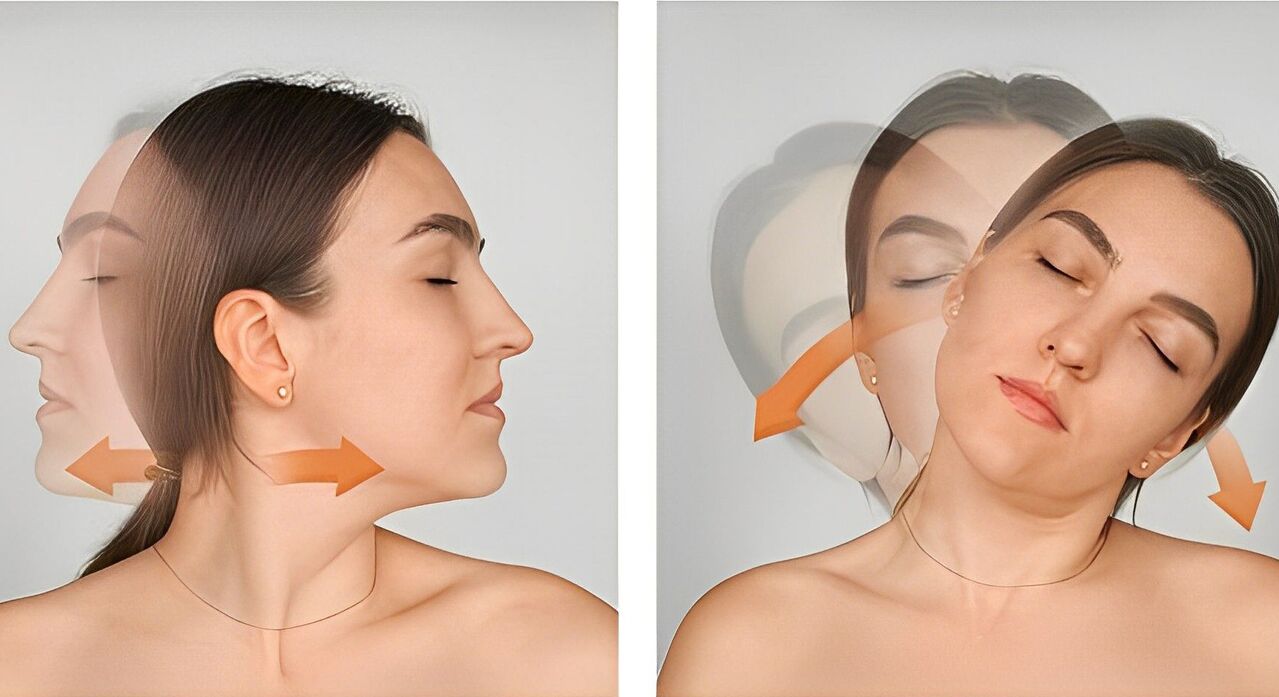
An important condition for the success of exercise therapy is a preliminary warm-up. Without this procedure, there is a risk of injury. Just rotate your shoulders a few times, turn your head gently to the sides and raise your arms. When the necessary muscles have warmed up, you can begin to perform the main complex.
10 classes showing how to stretch the neck with cervical spondylosis, strengthen the cervical spine and maintain vertebrae health:
- Relax tired muscles.Standing, hands free. Tighten your palms into fists and tense all the muscles in your arms. At the same time, lower your shoulders, straighten your back and maintain a tense position. Hold for 30 seconds, then open your palms and relax. After 30 seconds, repeat the tension position.
- From any body position that feels comfortable to you.Look straight ahead. Then slowly tilt your head to the left. Try to touch your ear to your shoulder without moving your hand or lifting it forward. Perform rhythmic movements, feeling your muscles stretch. Hold the bowed position for 10-15 seconds, then stand straight and repeat to the right. As you move, focus on the sensations.
- Pendulum or rotation of head bowed.Choose a position that is comfortable for you. Bend your head forward so that your chin touches the space next to the jugular vein. Stop for a second, feeling the stretch in your back muscles. Then, gently, without lifting the chin off the skin, start moving to the right, reaching the shoulder area and holding there. Return to the starting position, then repeat in the opposite direction. Do 7-10 repetitions in different directions.
- Raise your shoulders.Warming up the shoulder muscles plays an important role. Be in a state of relaxation. Then simultaneously raise both shoulders as high as possible, trying not to move them. Then relax by lowering your shoulders and moving them back a little. Repeat 5-10 times. Watch your breathing as you do it.
- Movement in the opposite direction.Initially, completely relax your shoulders. Then we stretch both at the same time and move them forward. Then we pull it out, stand up straight, trying to bring our shoulder blades together. Freeze slightly at the abduction points. Do it many times.
- Lean.Straighten your back and straighten your shoulders. Gently tilt your head down. But you cannot move your shoulders forward. Freeze for a moment, pick it up. Do this 5-10 times, always trying to lower your head. There shouldn't be any pain.
- Upper limbs and back.Can be performed in a sitting or standing position. Straighten and spread your arms, lower and relax your shoulders. Then tense your back and squeeze your shoulder blades together. Relax by moving your arms slightly forward. Do it 5-7 times, paying attention to not moving the upper limb itself, all movements are carried out by the efforts of the spinal muscles.
- Rotate the brush.Spread your arms as before, lowering your shoulders. Bend your elbows up and clench your palms into fists. Keeping your elbows perpendicular to the floor, rotate your fists 4 times clockwise and counterclockwise. The main task at this time is the fixed position of the hand.
- Rotation.We are still in the same position as before. Relax your upper limbs up to the elbows, then make some rotational movements with the elbows, first in one direction, then in the other. Place your hands at your sides. Do 5-7 sets - repeat.
- Shoulder rotation.Spread your upper limbs, relax your shoulders. Then do 4-5 rotations forward and then back to the shoulder joint. Relax, do it a few more times.
Gymnastics therapy for shoulders and neck is part of a complex of dizziness and headache treatment for men, women and the elderly. This is the best and effective static warm-up method for vertebrae with spondylosis. Spine at home, which professional trainers show you how to do, but in case of serious illness, you should abstain from it.
Diverse lesson system
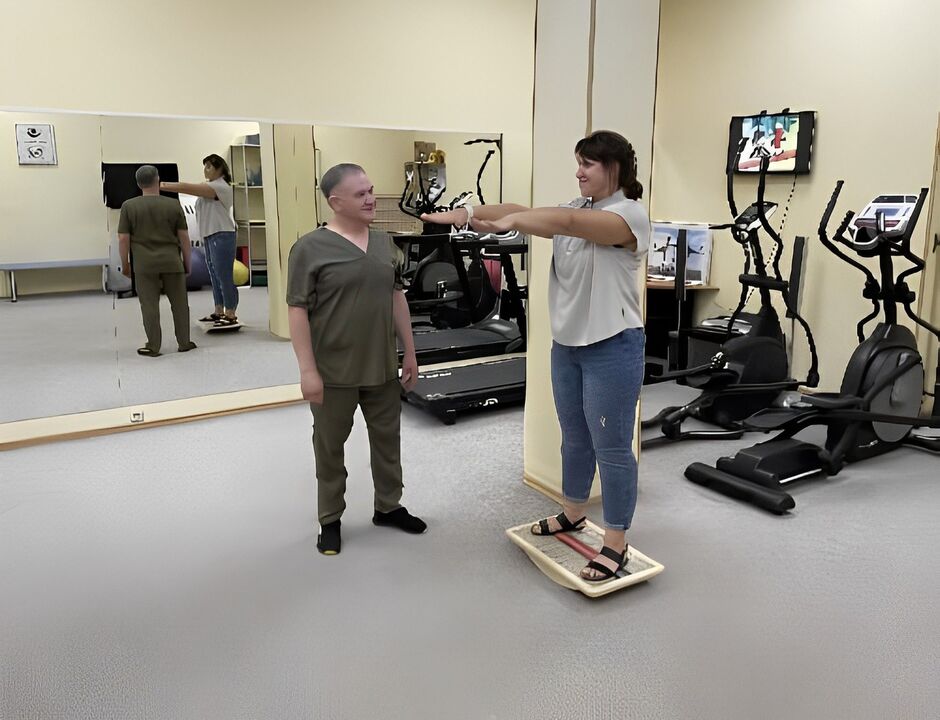
Many experts, knowing about the prevalence of this problem, have developed separate sets of exercises and gymnastics for women and men to strengthen the shoulder and neck muscles with cervical spondylosis, whichThis should be done when having a headache in the back. of the head and improve blood circulation in the brain, consider this the best and most effective way to practice at home. The effectiveness of exercise therapy has been proven if done properly and regularly.
Static exercises
There's actually no need to move. These can be done at your desk in the office:
- Place your palm on your forehead.Tense the muscle layer, try to put pressure on the palms to move them and lean forward. At the same time, you need to tense your arms and resist. You need to spend 20-30 seconds in a tense state, then completely relax and repeat after 10-20 seconds.
- Place your hands behind your head, first squeezing them together.Try to use force to tilt your head back and this time use your hands to resist the movement. Spend 15-30 seconds in a state of tension. Repeat 4-5 times.
- Place your hand on top without releasing the lock.Now you need to press directly on the top of your head and actively resist the pressure, trying to act as if you are pulling your head up. Duration is the same as previous lessons.
- Move your hand in a lock pattern to the base of the skulland press, actively resisting pressure, trying to lean your head back.
Repeat each time 3-4 times. It's important to keep track of how you feel.
Dikul's exercises
This complex is known to be perfect for people suffering from advanced osteoarthritis. Anyone can do it at home.
Smooth movement is important.
- Place your right hand on your left ear. At the same time, lift your left body up, slightly bending your elbow to shoulder level. Use your main hand to gently tilt your head by pressing on the ear area. Fix in 7-10 seconds. in this location. Then do the opposite.
- Raise your arms and clench your palms.Gently place them on the back of your head and gently press, tilting your head. At the same time, bend your body and arch your back. Hold this position for a few seconds and then slowly straighten.
- Place your elbow on the table and rest it comfortably.Place your palm around your lower jaw. Stretch your neck and try to gently move your head in different directions in this position.
- With your palms connected, press on the occipital area.Overcoming resistance with the help of neck muscles, try to throw your head back
Exercises according to Bubnovsky
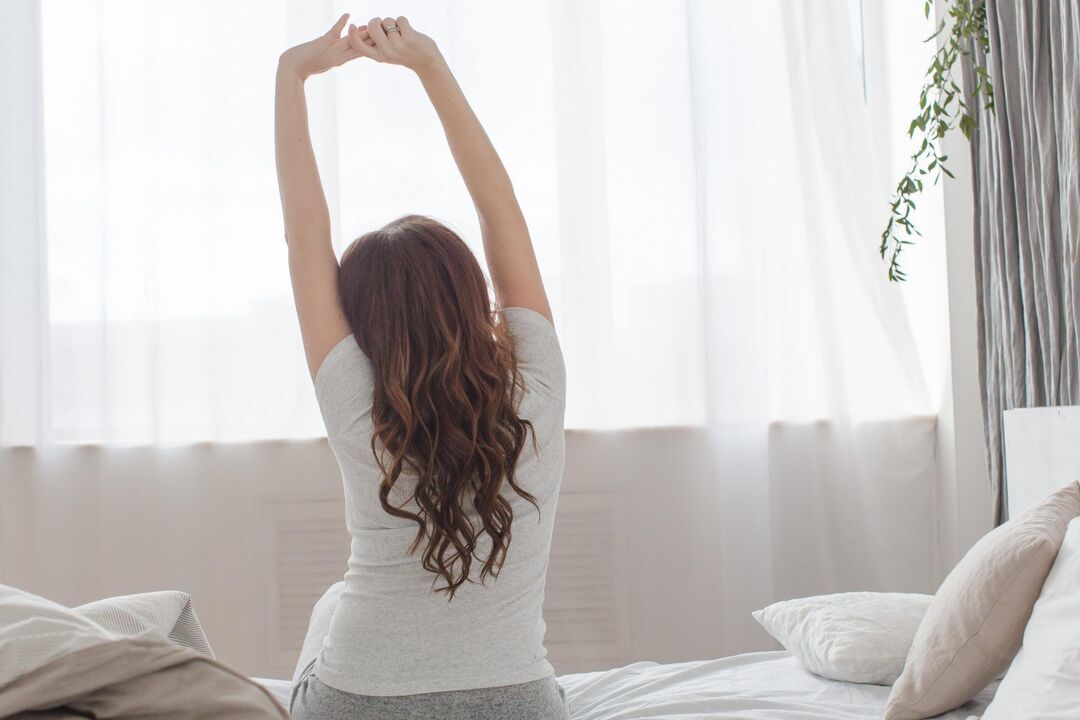
They can be used even for high blood pressure and headaches. Pain may occur. The doctor who developed the complex advises to continue taking it if the pain is moderate.
The most effective:
- Lower your head to your chest and relax.Then tighten the neck muscles and stretch the head forward. At each extreme point of movement, stop briefly.
- In the same locationAlternately pull the lower jaw toward the armpit.
- Return to the first position.Change the position of the head to the right, then tilt it back and look up at the ceiling. Slowly return to the starting position and repeat the movement.
- Clasp your hands together from above and look at them from bottom to top.Spread your arms to the sides, move your neck and look at your left and right hands respectively.
- Stretch your arms up and palms facing outward.Make sure your chin is parallel to the floor and slightly moved forward.
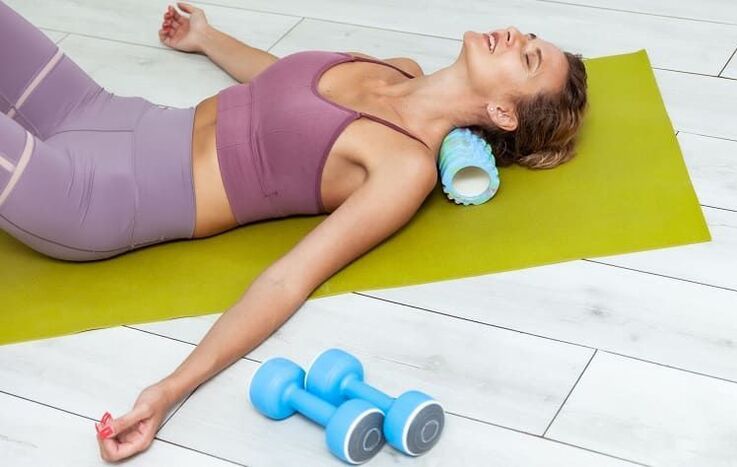
Doctors also develop useful strength exercises.You can implement them yourself:
- Push-ups on a chair.Place your palms on the outstretched arms on the seats of the two chairs. We leave our feet on the floor or raise them to the level of the chair, for example, placing them on the sofa. We perform push-ups smoothly and slowly. Sudden movements must be avoided.
- In a lying position, hold dumbbells in your hands.Inhale, raise, exhale, slowly lower them with your head.
- Without changing the location and equipment, we continue to do this. Exhaling, we return to the position in front of us and on exhalation we move away from each other so that our palms do not touch the floor.
When first starting to workout, do the movements 3-5 times if you are inexperienced. Gradually increase the number of repetitions and increase to 15 each time.
Contraindicated

Your doctor will tell you what exercises you cannot do with cervical spondylosis at home, as well as what you can and should do. The complexity and load, number of approaches are selected individually. There are a number of contraindications when performing physiotherapy complexes. The main thing is the acute phase. During this period, excessive physical activity only aggravates the degenerative disease. It is possible to start classes only after receiving permission from the coach and under his supervision for the first time. Other contraindications are divided into temporary and absolute.
You should abstain from exercising for a while:
- If complications are identified.
- In the presence of other chronic diseases that have become acute.
- Infection of the body due to any type of parasite: virus, fungus, bacteria.
- Severe stage of osteonecrosis, complete a course of treatment.
- Neck inflammation.
- Damage to the muscles or skin of the neck, abrasions, cuts, bruises, consequences of blows and falls.
- Attacks aggravate pathologies of the cardiovascular system.
- Fever, viral diseases leading to increased body temperature.
- Chronic or temporary fatigue.
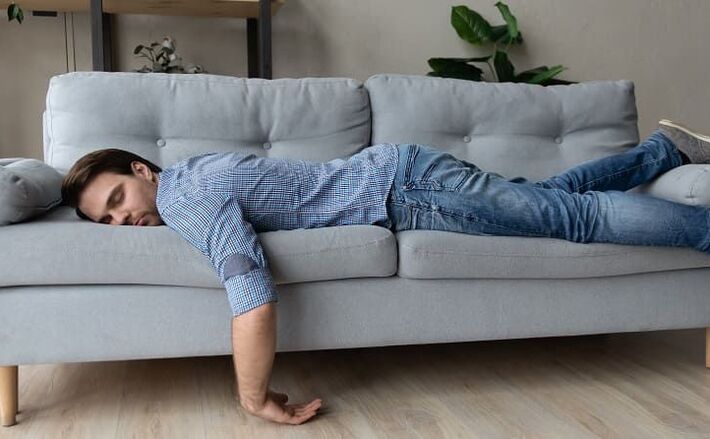
Exercises should not be used in patients with:
- A strange object of any origin located near large ships.
- Detect embolism and blood clots.
- Presence of bleeding of any intensity.
- Serious diseases of the heart and blood vessels, especially during exacerbation.
- Stage 2-3 atrioventricular block.
- Cancer. Melanoma.
- Significant deterioration on ECG.
A series of exercise therapy exercises for the neck and shoulders to relieve pain caused by cervical spondylosis will be different for everyone, what movements to perform during gymnastics and exercisesdaily should be determined by the attending physician. Only with the individual choice of the program can its effectiveness and safety be guaranteed.
How to increase the effectiveness of classes
During the period between exacerbations, in order not to take additional medications and avoid the progression of the disease, it is important to achieve results from exercise for cervical spondylosis.
To increase efficiency, you must follow some rules:
- Do the exercises at least 5 times a week.Ideally, daily loading is needed to achieve consistently high results.
- Performing the complex 2 times a day is necessary for people who lead a sedentary lifestyle., spending a lot of time in front of a computer or in a static position causes neck strain. Such people are at risk of getting sick, so they need to pay more attention to prevention.
- Exercise does not stop after the symptoms of the disease disappear.If you do not regularly maintain your level of physical activity, osteoarthritis will quickly return.
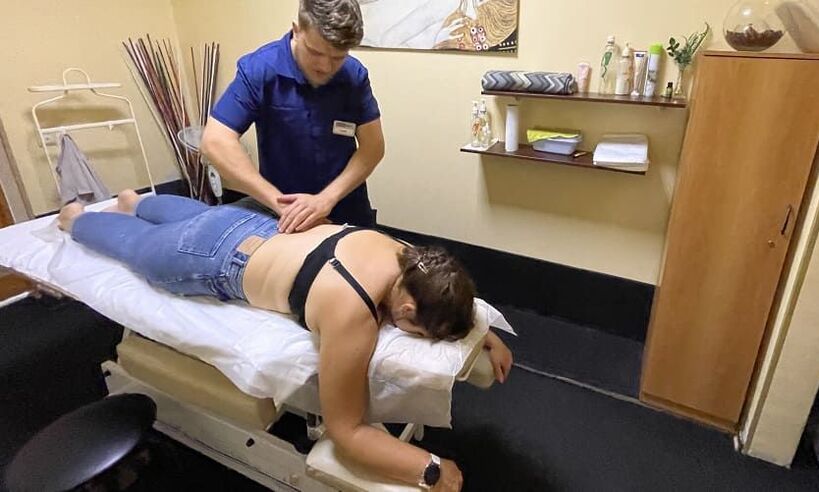
It is also possible to increase your effectiveness against disease by adding some helpful lifestyle changes to your set of exercises:
- Nutrition.Following a special diet can significantly slow the development of osteonecrosis. In your daily diet, you should significantly reduce the amount of salt, spices, vinegar, fermented milk products and curds with artificial additives, dyes and soda. Reduce the level of alcohol consumption and give up smoking, as the substances contained in alcohol or released when smoking have an extremely negative effect on bone strength.
- Take cold and hot water baths– a tool that allows you to easily improve blood circulation and nutrition in certain areas with nutrients. For maximum effectiveness, it should be taken daily at the end of the hydration process. The temperature should be changed within 1 minute (10-15 seconds for alternating hot and cold water). To achieve the best results, the water jet should be directed directly at the neck and shoulders.
- Massage– a good remedy to help reduce fatigue and prevent muscle spasms. It is recommended to undergo a professional neck, neck and shoulder massage every six months. At the same time, regularly perform self-massage to reduce fatigue.
Exercises for cervical-arm osteoarthritis are one of the most important measures to maintain health and prevent exacerbations and further development of the disease. Therefore, you should be mentally prepared that morning exercise therapy will always accompany you.
Preventive exercises
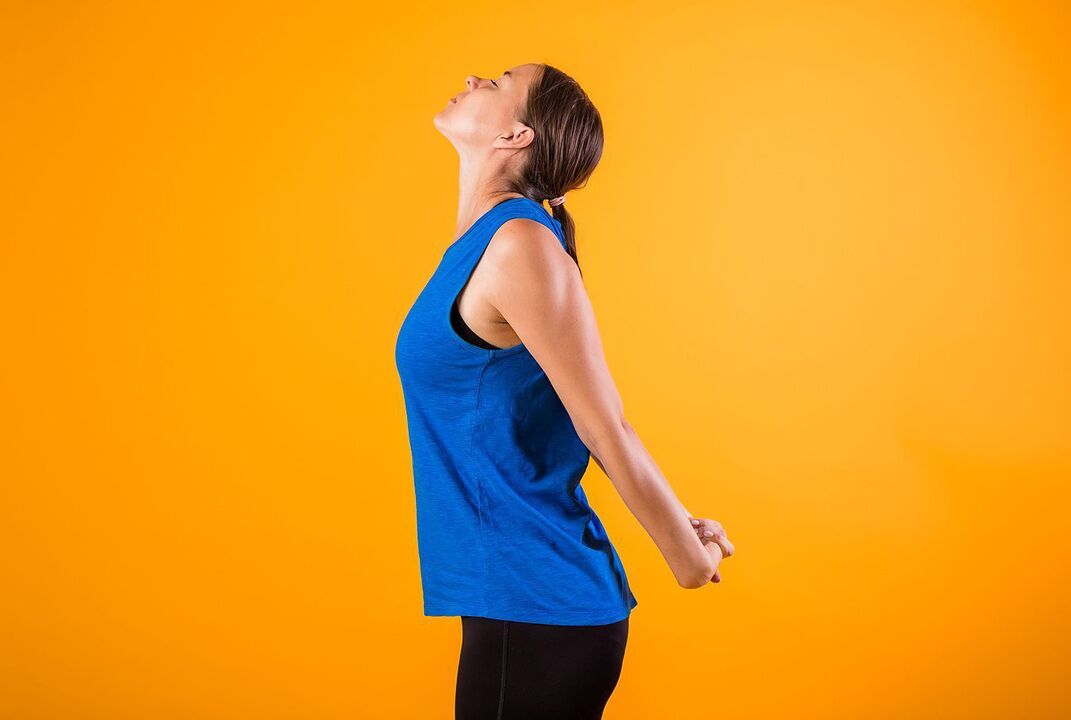
The main task is to strengthen neck muscles and stretch for cervical spondylosis. By practicing regularly, you can forget about severe pain and pain that requires drug treatment for a long time. That is why most people who have encountered this disease or are trying to avoid it prefer to regularly engage in prevention, protecting the intervertebral disc from unnecessary stress.
As preventative exercises, you can do any exercise you like. You should do each exercise 15-20 times a day.
Another effective way to avoid problems with any part of the back is to practice sports regularly. The sports most beneficial for the back are swimming, aqua gymnastics, handball and other activities that cause stress in the water.
In preventive exercises, an important factor for success is the correct load. To keep your back healthy, consider your age and physical characteristics and avoid overtraining.

























